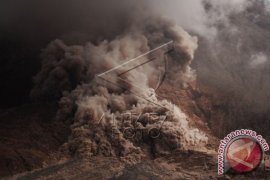The eruption was recorded on the seismogram and showed a maximum amplitude of 55 mm and a duration of about three minutes and 21 seconds, Acting Chief of the Karo District Disaster Mitigation Board (BPBD) Natanail Perangin-angin said.
The 2,451-meter high volcano had erupted at 8:10 p.m. WIB on Monday (January 18, 2021), but the height of the ash column was not observed at the time, too. The eruption was recorded on the seismogram and showed a maximum amplitude of 25 mm and a duration of about three minutes and 26 seconds.
Related news: Mount Sinabung spews clouds of hot ash again
The volcano’s alert status is currently at level III. Residents and farmers have been advised not to carry out any activities within a three-kilometer radius of the volcano's peak, a five-kilometer sectoral radius in the southeast sector, and a four-kilometer radius in the northeast sector, Perangin-angin said.
He said in the event of ash rain, residents must wear masks while venturing outdoors to reduce the adverse impact of inhaling volcanic ash on their health. They must also keep clean water at hand and rid roofs of thick volcanic ash to prevent their homes from collapsing, he added.
People residing near rivers whose upper reach is in Mount Sinabung must stay alert for the danger of lava, he said.
Mount Sinabung has repeatedly erupted since 2010, displacing tens of thousands of people in disaster zones.
Last year, the volcano had erupted early on the morning of August 8, spewing a two thousand-meter-high ash column. The eruption had affected local residents in the sub-districts of Teran, Berastagi, Simpang 4, and Merdeka.
In November, 2020, the volcano spewed clouds of hot ash for two consecutive days, according to the Volcanology and Geological Disaster Mitigation Center (PVMBG).
Related news: Volcanic ash from Mt Sinabung affects four sub-districts
Translator: Munawar Mandailing/Suharto
Editor: Rahmad Nasution
Copyright © ANTARA 2021











